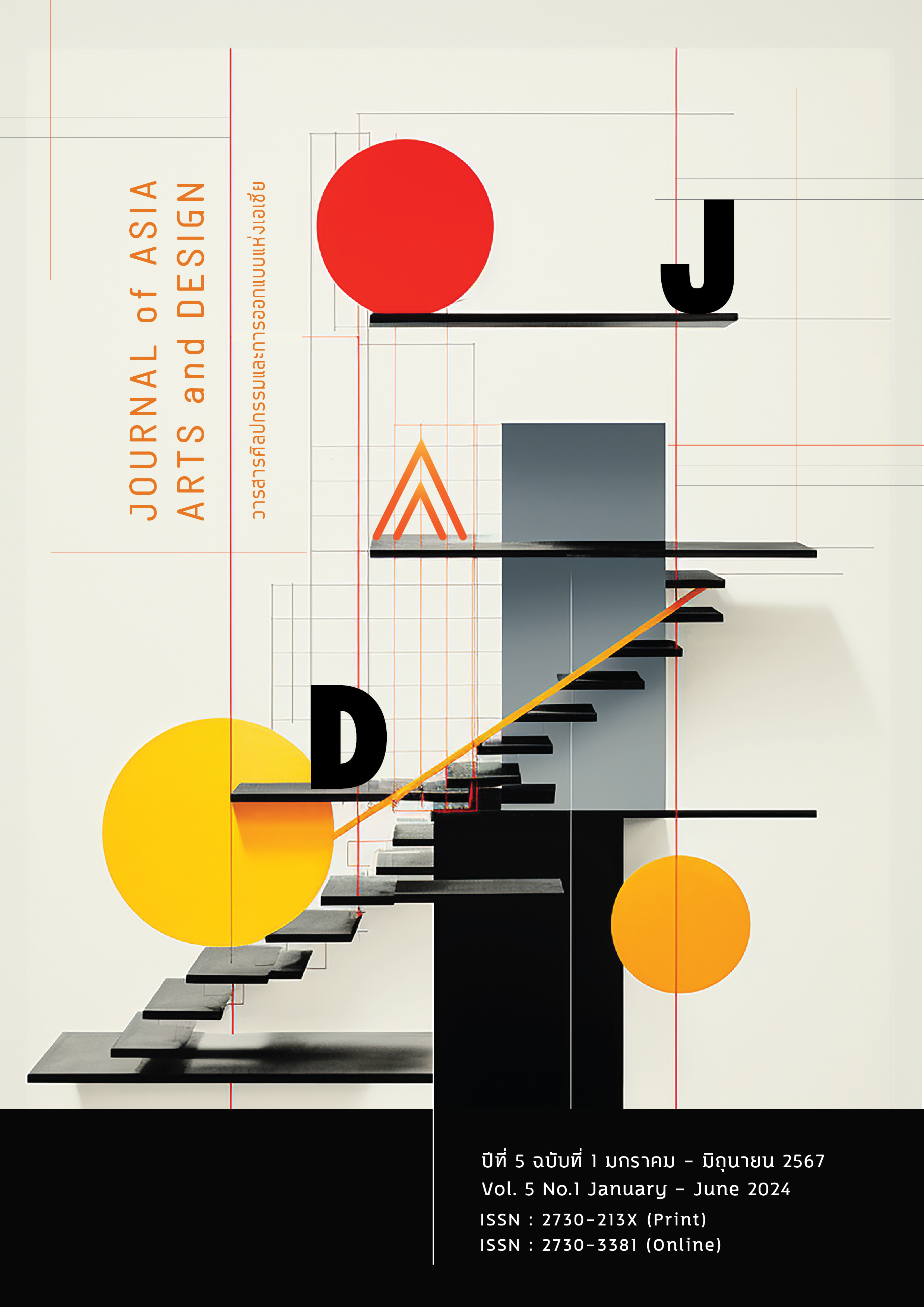SYMBOL OF URBAN LIFE: SCULPTING THE DYNAMICS OF FAMILY AND MODERNITY IN URBAN CHINA
Main Article Content
บทคัดย่อ
This study investigated the profound transformations within urban family structures in modern China, amidst the country’s rapid urbanization following the reform and opening-up policy. Utilizing an interdisciplinary approach, the research explored the socio-economic and cultural shifts influencing family dynamics, particularly focusing on the experiences and environmental interactions of younger urban dwellers. The research involved extensive fieldwork in Baoshan City and a critical review of literature spanning life-course theory, modernization theory, and gender equity theory. The findings highlighted the evolving roles within the urban Chinese family and the challenges posed by urban living. The core of the investigation lay in synthesizing these themes through visual arts, with a series of sculptures encapsulating 'The Symbol of Urban Life'. Drawing inspiration from the works of Henry Moore, Antony Gormley, and Julian Voss-Andreae, the sculptures acted as a narrative tool, dissecting, and reconstructing the layered complexities of urban existence. The resulting sculptures depicted the urban experience and provided analytical and sociological commentaries on the state of the family in urbanized China. Suggestions for future research involved interactive public art installations and examining the psychological impact of living in high-density urban environments, advocating for a cross-disciplinary approach to further explore the dynamic interplay between urban studies, psychology, and visual arts.
Article Details
เอกสารอ้างอิง
Applebaum, R. P. (1970). Theories of social change. Chicago, IL: Markham.
Becker, G. S. (1981). Altruism in the family and selfishness in the marketplace. Economica, 48(189), 1-15.
Chan, K. W. (2010). Fundamentals of China’s urbanization and policy. China Review, 2010(1), 63-93.
Djundeva, M., Dykstra, P. A., & Emery, T. (2019). Family dynamics in China and Europe in the last half-
century. Chinese Journal of Sociology, 5(2), 143-172.
Fei, W., & Zhao, S. (2019). Urban land expansion in China’s six megacities from 1978 to 2015. Science of the
Total Environment, 664, 60-71.
Gormley, A., Hutchinson, J., Gombrich, E. H., Njatin, L. B., & Mitchell, W. J. T. (n.d.). Antony Gormley. London:
SteidlMack.
Gu, C., Kesteloot, C., & Cook, I. G. (2015). Theorizing Chinese urbanization: A multi-layered perspective.
Urban Studies, 52(14), 2564-2580.
Hagestad, G. O., & Dykstra, P. A. (2016). Structuration of the life course: Some neglected aspects. In M. J.
Shanahan, J. T. Mortimer, & K. Johnson (Eds.), Handbook of the life course (pp. 131-157). Dordrecht:
Springer International Publishing.
Hu, Y., & Shi, X. (2020). The impact of China’s one-child policy on intergenerational and gender relations.
Contemporary Social Science, 15(3), 360-377.
Jankowiak, W. (2019). Family life in China. In J. Liu & J. Yamashita (Eds.), Routledge Handbook of East Asian
Gender Studies (199-216). London: Routledge.
Lesthaeghe, R. (2014). The second demographic transition: A concise overview of its development.
Proceedings of the National Academy of Sciences of the United States of America, 111(51), 18112-
Li, G., & Li, F. (2019). Urban sprawl in China: Differences and socioeconomic drivers. Science of the Total
Environment, 673, 367-377.
Li, T., Fan, W., & Song, J. (2020). The household structure transition in China: 1982-2015. Demography,
(4), 1369-1391.
McDonald, P. (2006). Low fertility and the state: The efficacy of policy. Population and Development
Review, 32(3), 485-510.
Moore, H. (1998). Celebrating Moore: Works from the Collection of the Henry Moore Foundation. Berkeley,
CA: University of California Press.
Ong, L. H. (2014). State-led urbanization in China: Skyscrapers, land revenue and “concentrated villages”.
The China Quarterly, 217(1), 162-179.
Shen, K., Cai, Y., Wang, F., & Hu, Z. (2021). Changing society, changing lives: Three decades of family
change in China. International Journal of Social Welfare, 30(4), 453-464.
Song, J., & Ji, Y. J. (2020). Complexity of Chinese family life. China Review, 20(2), 1-18.
Qi, Z. (2019). An overview of rural to urban migration in China and social challenges. Migration Letters,
(2), 273-282.
Thornton, A. (2001). The developmental paradigm, reading history sideways, and family change.
Demography, 38(4), 449-465.
Thornton, A., & Philipov, D. (2009). Sweeping changes in marriage, cohabitation and childbearing in
Central and Eastern Europe: New insights from the developmental idealism framework. European
Journal of Population, 25(2), 123-156.
Van de Kaa, D. J. (2001). Postmodern fertility preferences: From changing value orientation to new
behavior. Population and Development Review, 27(Supplement), 290-331.
Voss-Andreae, J. (2013). Quantum man. The STEAM Journal, 1(1), 20.
Wanting, S. H. I. (2021). Characteristics of time-space utilization and its gender differences in traditional
family model: A case study of stem family and nuclear family. Journal of Landscape Research, 13(4), 19.
Xu, A., & Xia, Y. (2014). The changes in Mainland Chinese families during the social transition: A critical
analysis. Journal of Comparative Family Studies, 45(1), 31-53.
Zheng, J. (2019). Producing Chinese urban landscapes of public art: The urban sculpture scene in
Shanghai. The China Quarterly, 239(1), 775-803.


